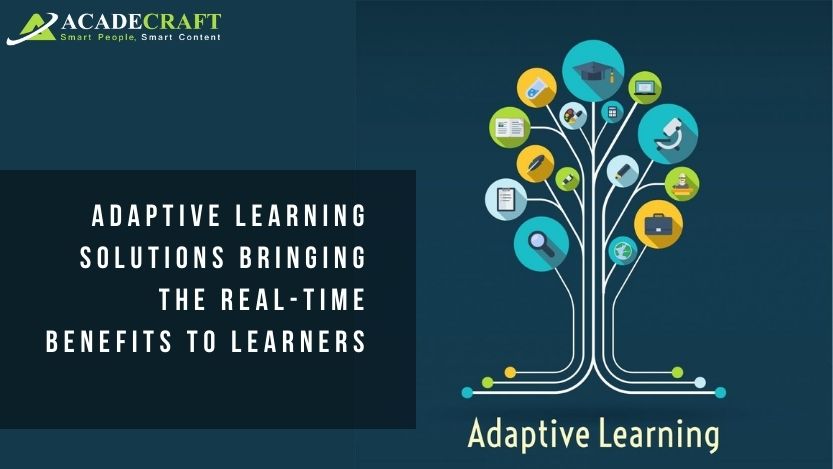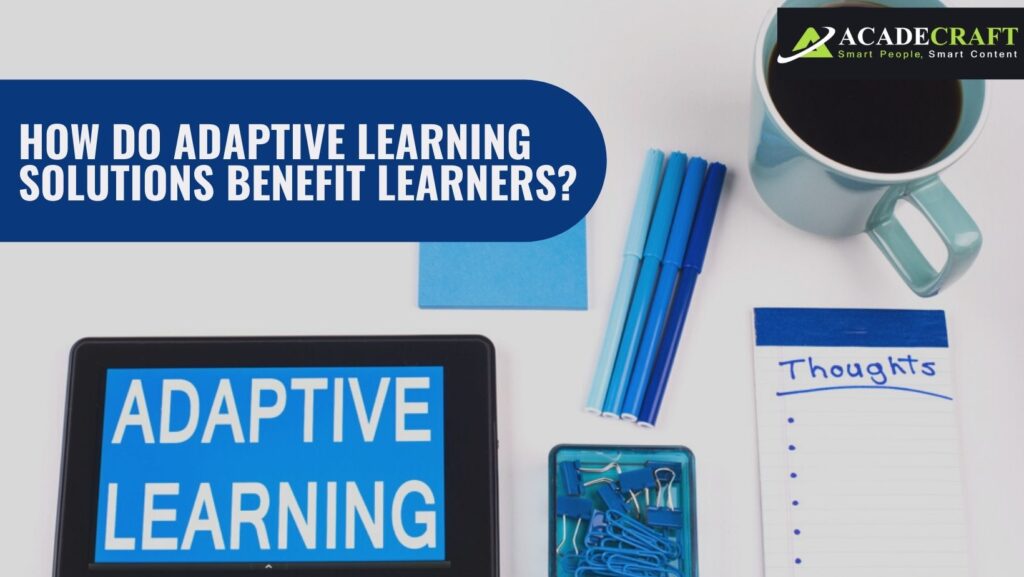
The power of learning has endless dimensions and potentials. Every student has the right to learn. The traditional learning methods were good. However, now they are rusted and worn out. When the whole world is catching up with new technological advancements, the learning industry should too. Adaptive learning solutions are precisely what the prevailing education system needed. Ticking all the boxes, adaptive learning brings in a new phase of a customized learning experience.
Beholding Artificial Intelligence at its core, adaptive learning is here to bring a change. But, what is this change that we are talking about?
The learning industry has seen quite a number of advances in different ways. From the introduction of AR and VR to gamification, we have come a long way. But adaptive learning is big.
On a broader outlook, it is a tech-savvy way of delivering learning content. Its primary goal is to ensure better learning outcomes.
With that brief introduction, let's head straight towards the blog. Here, we'll talk about how to choose an effective adaptive learning platform. Besides that, we'll also discuss its importance to learners and other things.
While talking about learning strategies, know that there is no one-for-all magical solution. Every learner is different in a wide range of aspects. Some are good learners, while others are good knowledge retainers. There is no absolute parameter to fix all of them together.
Creating a standard adaptive eLearning course requires the right technologies. To know that, we need to first understand what to expect.
Adaptive learning should be able to answer -
If the adaptive learning system answers these five questions, it is good to go. But, that is not where it ends.
Before implementing such adaptive learning services, it is vital to understand the requirements.
Here are the top six criteria for a successful adaptive learning program -
Like every other interactive eLearning software, adaptive learning solutions need to have a definite purpose. It cannot be a vague solution that promises to bring changes.
The adaptive technology that will be used should be purpose-driven. It should show how engaging and impactful content will bring in a change. The program needs to be capable of delivering student insights in a detailed manner.
The curriculum should have adequate adaptive opportunities for learners. What that means is that the learning objectives should match with real-world solutions. They should not be based entirely on the trivial methods mentioned in the syllabus.
As we are looking for learner-centric adaptive learning solutions, the alignment should be optimum. To elaborate, it should match the learning pace of the individual. The adaptive application software must deliver dynamic curriculums. The contents, the assignments, and the adaptive solutions need to match a student's capabilities.
What is a doctor if he cannot diagnose a patient properly? Similarly, in adaptive learning, there should be plenty of adaptive programs. These programs should be able to execute automated diagnostic assessments on the learners.
By doing so, there will be accurate insights for them. The learners, their parents, and the educators will know the progress level of the student.
Does he need more practice to overcome a difficulty? Or, does she need a teacher's help to get better eventually. The adaptive learning platform should be able to answer all these questions.
Only after that, we can conclude that it has an excellent student assessment or diagnostic system.
Games are popular among learners of all age groups. Games engage learners and facilitate higher concentration. Learners who play games are expected to have a better eye for detail. They also have a greater understanding of picking up what's right and what isn't.
Talking about games, there must be interactive games for learners in the adaptive program. Gamification has secured a solid position in the customized eLearning industry. The way it attracts students of all ages makes it an important asset.
Gamification increases a student's awareness and levels of understanding. They develop a foundation of their own, where they make their own choices.
Having provisions for feedback is essential to show a willingness to improve. It paves the way for the person to understand the mistakes. Suggesting possible changes through feedback ignites a passion for working harder.
Everything said above are the top criteria of adaptive eLearning. The curriculums should provide immediate feedback for submitted assignments. It should be proactive and provide interactive support to learners. As a result, they will learn from their mistakes and gather knowledge from them.
Simulations can change the perceptions of what we see or envision. That is why adaptive learning methods involve different simulations and challenges. It engages students in different activities through experiential games and virtual projects. Adding a variety of simulated instructions increases students' attention. They no longer commit disciplinary indecencies.
Those days are gone when classroom learning was hailed supreme. With the Covid-19 pandemic, the world understood the importance of digital learning methods. Not that it was something new, but it surely was more popular than before.
Adaptive learning brought in several features for today's learners. Its benefits are widespread and have helped students reach their goals easily.
Let's dive in and check out its pros.
It is true that eLearning trends like adaptive learning have brought different innovations for learners. However, as everyone might expect, it is nothing like a science fiction movie. There are no laser beams that transfer knowledge straight into the brains.
Keeping jokes aside, it would be wrong to say that adaptive learning solutions are just complex algorithms. Instead, it is a series of such algorithms that keep building massive data structures. These data structures then create a series of decision-making chains. What these chains do is unique.
They create a refined instructional methodology. That methodology can understand learners. They also evaluate their learning powers and knowledge retention skills.
Adaptive learning focuses on personalized ways of learning. The concepts that the educators impart directly match with a learner's individual abilities. It is quite different from classroom learning, where, unlike adaptive learning, it implies a one-for-all learning approach.

Personalized teaching brings automation of learning environments to learners. Not just learners, even teachers have an expanded education reach. Having access to different modern educational tools, they are also exploring this wide spectrum. They now have the chance to personalize learning methodologies while automating them.
Just like we always say, no two students are the same. They have different skills, mindsets, and learning capabilities.
In an ever-expanding classroom, teachers fail to deliver full attention to each student individually. What happens is that some students start lagging. They lack the proper guidance and attention that they need. As a result, their academic growth starts growing in a degrading way.
Students never get the required push that they needed from their teachers. Thus, they often submit incomplete assignments or score bad grades.
Any professional adaptive learning platform will solve this issue. In this mode of learning, students connect with their teacher in a one-to-one model. So, knowledge gaps decrease considerably.
As said before, traditional classrooms have an ever-increasing size. It is impossible for teachers to focus on individual students. Thus, we can also assume that teachers have little to no insight into students' performances.
Adaptive learning solutions eliminate this issue. It provides teachers plenty of ways to keep track of a student's progress. They can get all the information about their academic career. Thus, it helps to know how good or bad they are doing.
What makes the name 'adaptive' learning then? Well, for students who are doing great, teachers let them roll on their own. On the contrary, teachers can give their utmost attention to those who are suffering.
Around 7% of high school learners in the US drop out before graduation. Half of the college students fail to complete their course before six years. Also, a large number of them still fail to graduate.
Now, these facts clearly portray how there is a loophole in the traditional learning methods. Thousands of students fall behind in the race to get degrees. Ultimately, they give up on their dreams and move to other fields.
Learners who are having a hard time with their academics need some help. They need their teachers to guide them. And this guidance is only possible through adaptive learning. Therefore, with a bit of help, learners can save their degrees and confidence.
The sole purpose of attending classes regularly is to stay connected with teachers. Teachers are supposed to spend more time on weaker students. But, this does not happen in traditional classrooms.
The scenario is different in adaptive learning methods. Here, students who need support get it in plenty from their teachers. It solidifies the student-teacher bond while making students figure out their problems.
Assignments and other interactive evaluation tests go on for students. But, there is a big caveat of traditional classroom learning - Feedback.
Feedback is vital for all types of learners. Regardless of their age groups, they need feedback and suggestions to keep evolving. Even in the case of mistakes, feedback helps students in learning from them and moving ahead.
In adaptive learning, learners are free. They can study whenever they want. And they get instant feedback from the adaptive learning platform on various occasions. That really motivates them to do more.
One of the best things about adaptive learning is its convenience. No, we are not talking about what we discussed in the last point.
Specific modern eLearning methods require a heavy tech to operate. Somehow the ease of learning gets faded in between somewhere. But, adaptive learning solutions are different.
Learners can even use the tech that they have with them. Not just laptops or computers, they can have access to their progress from their smartphones too. This brings in a fresh layer of convenience over the already prevailing ones.
Besides being extremely student and teacher-friendly, adaptive learning is much more. Talking of which, we find how it is not only flexible but also engaging.
Flexibility, on the first note, is definitely one of the key propositions of it. It gives learners the flexibility to learn different things. They can also learn the same thing in different ways.
Next, moving to how it is engaging, well, there are obvious reasons. The techniques of adaptive learning provide fascinating teaching methods. From interactive classes to gamification methods, there are many. Learners are excited to complete their daily tasks as they are everything but boring.
Educators know what is good for students. However, their research is based on manual practices and observations.
When technology intervenes, the scenario changes. Technology cultivates scientific data behind learning. It collects facts and figures through assessments before deciding what is suitable for every student. Although, based on man-made algorithms, the end result is mostly better.
Adaptive learning helps online students learn with increased efficiency. They provide better options in every direction. Thus, they compel learners to be the best version of themselves.
The biggest thing that appeals to students regarding adaptive learning solutions is convenience. Students love to study at their chosen time and pace. It gives them adequate breathing space in their lives. In addition, they have room for other activities and hobbies too.
Alongside these, adaptive learning also gives teachers better insights. Unlike before, they now get to know each student individually. They get to connect with them better. In conclusion, the growth of adaptive learning looks quite promising for both learners and educators.
Share